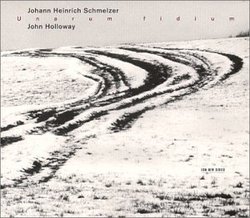| All Artists: Anonymous, Antonio Bertali, Johann Heinrich Schmelzer, Lars Ulrik Mortensen, Aloysia Assenbaum, John Holloway Title: Schmelzer: Unarum Fidium /Holloway * Assenbaum * Mortensen Members Wishing: 2 Total Copies: 0 Label: ECM Records Release Date: 4/25/2000 Genre: Classical Styles: Chamber Music, Historical Periods, Baroque (c.1600-1750), Classical (c.1770-1830), Instruments, Strings Number of Discs: 1 SwapaCD Credits: 1 UPC: 028946506622 |
Search - Anonymous, Antonio Bertali, Johann Heinrich Schmelzer :: Schmelzer: Unarum Fidium /Holloway * Assenbaum * Mortensen
 | Anonymous, Antonio Bertali, Johann Heinrich Schmelzer Schmelzer: Unarum Fidium /Holloway * Assenbaum * Mortensen Genre: Classical
|
Larger Image |
CD Details |
CD ReviewsIs this classical?? John Willoughby | Amherst, MA | 05/24/2006 (5 out of 5 stars) "That "Is this classical??" was a question from a colleague when I first put this CD on at work. The organ and harpsichord continuo produce such a "beat" that I could understand him needing to ask the question. The the violin begins to weave it's complex thread. By the second track my colleague had the answer to his question but was hooked. It's a very seductive, atmospheric piece. Surely obscure stuff like this shouldn't be so accessible?" Gentle Music, Beautiful Performance Giordano Bruno | Wherever I am, I am. | 09/19/2007 (5 out of 5 stars) "Schmelzer is well-known to wind musicians as a composer of suitable occasional music, well-constructed, sonorous, and not over-challenging. These pieces come as a revelation of a deeper musical spirit. They are modest and serene, and very thoughtful. What makes this CD special is the superb playing of John Holloway. I've heard him play many times, on disks and live, and I've never enjoyed his musicianship more. His tone on the gut strings of his baroque violin is as smooth and vibrant as fine dark chocolate." Exquisite Claire | Australia | 02/27/2009 (5 out of 5 stars) "This is the most beautiful CD. It's uplifting, tight, clean, crisp and vigorous. Great listening."
|

 Track Listings (8) - Disc #1
Track Listings (8) - Disc #1